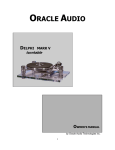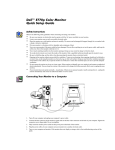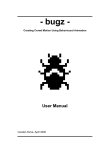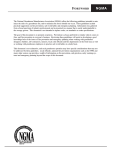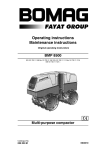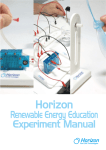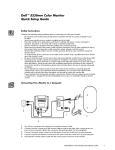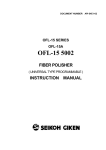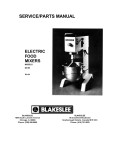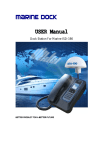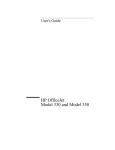Download Bomag BPR 50 User Manual
Transcript
Operating instructions Maintenance instructions %35'%35' S/N 101 690 27 ....> Hatz 9LEUDWRU\SODWH Catalogue number )RUHZRUG These BOMAG - machines are products from the wide product range of BOMAG compaction equipment. BOMAG’s vast experience, coupled with the most modern production and testing methods, such as lifetime tests of all important components and highest quality demands, ensure highest reliability of your machine. To comply with the technical development we reserve the right of modifications without prior notification. Using these instructions will Information for the correct use of our machines in earth and asphalt construction is also available from your BOMAG-dealer. F oreword ● help you to become acquainted with the machine. ● avoid faults caused by unprofessional operation. These operating and maintenance instructions are also available in other languages. In addition you can obtain a spare parts catalogue from your BOMAG dealer by just stating the serial number of your machine. The notes mentioned above do not constitute an extension of the warranty and liability conditions, which are part of the general terms of business of BOMAG. Observing the maintenance instructions will ● increase the reliability of the machine during use on site, We wish you much success with your BOMAG machine. ● prolong the lifetime of the machine, BOMAG GmbH & Co. OHG ● reduce repair costs and downtime. Printed in Germany Copyright by BOMAG BOMAG does not assume liability for the function of the machine ● if the machine is handled in a way, which does not comply with the use it is intended for, ● if it is used for purposes other then the ones mentioned in these instructions. No warranty claims can be lodged for damage resulting from ● operating errors, ● insufficient maintenance and ● the use of wrong fuels and lubricants. Please note! This manual was written for operators and maintenance personnel on construction sites. You should only operate the machine after you have been instructed to do so and by following these instructions. Please observe strictly the safety regulations. Please observe also the guidelines of the civil engineering liability association "safety rules for the operation of road rollers and soil compaction equipment", as well as the applicable instructions for the prevention of accidents. For your own safety you should only use genuine BOMAG spare parts. BPR 50/52 D3 - BPR 55/52 D-3 %20$ * 5 )RUHZRUG Please fill in ............................ Machine type (Fig. 1) ............................ Serial No. (Fig. 1 and 2) ............................ Engine type (Fig. 3) ............................ Engine No. (Fig. 3) L Note Fig. 1 Fill in the above listed data when receiving the machine. Upon receipt of the machine our organization will instruct you about correct operation and maintenance. Please observe strictly all safety regulations and notes on potential dangers! Fig. 2 Fig. 3 6 %20$ * BPR 50/52 D3 - BPR 55/52 D-3 Table of Contents 7HFKQLFDO'DWD 6DIHW\UHJXODWLRQV ,QGLFDWRUVDQG&RQWUROV 3.1 General notes 18 3.2 Controls 18 2SHUDWLRQ 4.1 General 22 4.2 Before starting work 22 4.3 Folding the steering rod down 23 4.4 Starting/stopping the engine, manual starting 23 4.5 Starting/stopping the engine/electric starter 29 4.6 Starting with jump wires 31 4.7 Work/operation 32 4.8 Loading 34 0DLQWHQDQFH 5.1 General notes on maintenance 36 5.2 Fuels and lubricants 37 5.3 Table of fuels and lubricants 38 5.4 Running-in instructions 39 5.5 Maintenance chart 40 5.6 Cleaning machine/engine 41 5.7 Checking the fuel level 41 5.8 Checking the engine oil 42 5.9 Checking the dry air filter 42 5.10 Cleaning the dry air filter 43 5.11 Checking the condition of the battery, greasing the poles 44 5.12 Draining the fuel tank sludge and water 45 5.13 Checking the oil level in the vibrator housing 46 5.14 Changing engine oil and engine oil filter 46 5.15 Checking, tightening, changing the V-belt 47 5.16 Checking, adjusting the valve clearance 49 5.17 Cleaning cooling fins and cooling air intake openings 49 5.18 Changing the fuel filter 51 5.19 Changing the oil in the vibrator housing 51 5.20 Check the hydraulic oil level 52 5.21 Checking the rubber buffers 54 5.22 Checking the condition of the machine and the tight fit of all screws 55 5.23 Engine conservation 55 7URXEOHVKRRWLQJ 6.1 General notes 58 6.2 Engine problems 59 BPR 50/52 D3 - BPR 55/52 D-3 %20$ * 7 Table of Contents 8 %20$ * BPR 50/52 D3 - BPR 55/52 D-3 1 Technical Data BPR 50/52 D3 - BPR 55/52 D-3 %20$ * 9 7HFKQLFDO'DWD Fig. 4 Dimensions in mm BPR 50/52 D-3 - BPR 55/52 D-3 H 850 * Weights Operating weight CECE (W) Operating weight CECE (W1) with extension plates Operating weight CECE (W2) with extension plates Drive Engine manufacturer Type Cooling Working cycles Number of cylinders Rated power ISO 9249 Rated speed Starting device Fuel Drive system 10 H1 1070 L 1890 L1 900 W 520 W1 660 W2 820 BPR 50/52 D-3 BPR 55/52 D-3 kg kg 446 463 446 463 kg 473 473 Hatz 1D 41 S Air 4 1 5,8 3400 Crank handle Diesel mechanical (V-belt) Hatz 1D 41 S Air 4 1 5,8 3400 kW rpm %20$ * Diesel mechanical (V-belt) BPR 50/52 D3 - BPR 55/52 D-3 7HFKQLFDO'DWD * BPR 50/52 D-3 BPR 55/52 D-3 m/min % ° 0...24 30 20 0...22 30 20 Vibration system Frequency Amplitude Hz mm 62 1,8 75 1,2 Filling capacities Fuel tank capacity Engine Vibrator system l l l 4 1,1 1 4 1,1 1 Travel characteristics Working speed max. gradability Permissible inclination * The right for technical modifications remains reserved BPR 50/52 D3 - BPR 55/52 D-3 %20$ * 11 7HFKQLFDO'DWD The following noise and vibration values according to the EC-machine regulation of revision (93/68/ EEC) have been measured under typical operating conditions for this machine with vibration and over a specified travel distance (DIN 45635). During operation these values may vary because of the existing operating conditions. Noise value The sound level according to enclosure 1, paragraph 1.7.4. f of the EC-machine regulation is sound pressure level on the operator’s stand: LpA = high amplitude 95.2 dB(A) / low amplitude 98.1 dB(A) sound capacity level: LWA = high amplitude 108.9 dB(A) / low amplitude 111.1 dB(A) These sound values were determined according to ISO 6081 for the sound pressure level (LpA) and ISO 3744, DIN 45635 for sound capacity level (L WA). Vibration value The vibration values according to enclosure 1, paragraph 2. 2 or 3. 6. 3. a of the EC-machine regulation are: Hand-arm vibration values The weighted effective acceleration value determined according to ISO 8662 part 1, DIN 45675, part 9 is 6.9 m/sec2 for high amplitude and 6.7 m/sec2 for low amplitude. 12 %20$ * BPR 50/52 D3 - BPR 55/52 D-3 2 Safety regulations BPR 50/52 D3 - BPR 55/52 D-3 %20$ * 13 6DIHW\UHJXODWLRQV General This BOMAG machine is built in accordance with the latest technical standard and the valid technical rules and regulations. However, dangers for persons and property may arise from the machine if it is: ● put to unintended use, ● operated by untrained personnel, ● modified or altered in an unprofessional way, ● the applicable safety regulations are not observed. Maintenance and repair tasks require specific knowledge and must therefore only be carried out by trained and qualified personnel. Furthermore the following regulations and instructions are obviously also valid: all applicable instructions for the prevention of accidents, ● generally acknowledged safety and road traffic regulations, ● country specific regulations. Intended use This machine must only be used for: ● compaction of all types of soil, ● repair work on all types of soil, ● reinforcement of pedestrian walkways, ● work in trenches, ● filling and compaction of hard shoulders. ● The machine should be checked by an expert once every year. Unintended use Dangers may, however, arise from the machine if it is used by untrained personnel in an unprofessional way or if it is used for purposes other than those mentioned in these instructions. 14 The machine must only be operated by trained and authorized persons who are at least 18 years of age. The responsibilities for the operation of the machine must be clearly specified and complied with. Persons under the influence of alcohol, medication or drugs must not operate, service or repair the machine. Each person involved in operation, maintenance and repair of the machine must therefore read and apply these safety regulations. If necessary this should be confirmed by obtaining the signature of the customer. ● Who is allowed to work with the machine? Conversions and alterations to the machine Unauthorized conversions to the machine are prohibited for safety reasons. Original parts and accessories have been specially designed for this machine. We wish to make expressly clear that we have not tested or authorized any original parts or special equipment not supplied by us. The installation and/or use of such products can impair the active and/or passive driving safety. The manufacturer expressly excludes any liability for damage resulting from the use of non-original parts or accessories. Safety notes in the operating and maintenance instructions: Danger Paragraphs marked like this highlight possible dangers for persons. Caution Paragraphs marked this way highlight possible dangers for machines or parts of the machines. L Note Sections marked like this provide technical information concerning the optimal economical use of the machine. %20$ * BPR 50/52 D3 - BPR 55/52 D-3 6DIHW\UHJXODWLRQV Environment Sections marked like this highlight activities for the safe and environmental disposal of fuels and lubricants as well as replaced parts. Operation Safety stickers on the machine Watch out for unusual noises and development of smoke. Perform trouble shooting and have the fault corrected. Operate the machine only with the steering rod folded down. Guide the machine so hat your hands do not hit against solid objects, danger of injury. Keep safety stickers in good condition and legible and follow their meaning. Operate the machine only with full engine speed, as otherwise the centrifugal clutch will be destroyed. Replace damaged and illegible safety stickers. Loading the machine Do not let the machine run unattended. Secure the machine against turning over or slipping off. Parking the machine Persons are highly endangered if they ● step under loads being lifted or ● stand under loads being lifted Park the machine on level, firm ground. Before leaving the machine: Secure the machine on the transport vehicle against rolling off, slipping and turning over. ● park the machine so that it cannot turn over, ● shut the engine down. Mark machines, which could be in the way, with a clearly visible sign. Starting the machine Before starting Filling the fuel tank Become acquainted with the equipment, the control elements, the working principle of the machine and the working area. Refuel only with the engine shut down. Do not refuel in closed rooms. No open fire, do not smoke. Wear your personal protective outfit (hard hat, safety boots, etc.). Wear ear defenders. Do not spill any fuel. Catch running out fuel, do not let it seep into the ground. Before starting the machine check whether: ● the machine shows any obvious faults ● all guards and safety elements are in place ● the controls are fully functional Maintenance work must only be carried out by qualified and authorized personnel. ● the machine is free of oily and combustible material Keep unauthorized persons away from the machine. ● all grips are free of grease, oils, fuel, dirt, snow and ice. Do not perform service work while the engine is running. Maintenance Use only machines which are serviced at regular intervals. If possible, park the machine on level and firm ground. Do not use any starting aids like start pilot or ether. Working on the engine For starting move your feet out of the danger zone of the base plate. Drain the engine oil at operating temperature danger of scalding! Starting in closed rooms Wipe off spilled oil, catch running out oil and dispose of environmentally. Exhaust gases are highly dangerous! Always ensure an adequate supply of fresh air when starting in closed rooms! BPR 50/52 D3 - BPR 55/52 D-3 %20$ * 15 6DIHW\UHJXODWLRQV Store used filters and other oil containing materials in a specially marked container and dispose of environmentally. Exhaust gases are highly dangerous! Always ensure an adequate supply of fresh air when starting in closed rooms! Working on electric components Mark defective machines by attaching a warning note to the steering handle. Before starting to work on electric components disconnect the battery and cover it with insulating material. Working on the battery When working on the battery do not smoke, do not use open fire. Do not let skin and clothes come in contact with acid. In case of injuries caused by acid flush the respective parts with clear water and consult a doctor for medical advice. Do not place any tools on the battery, danger of short circuit. When recharging the battery remove all plugs to avoid an accumulation of explosive gases. Dispose of old batteries environmentally. Working on the fuel system No open fire, do not smoke, do not spill any fuel. Catch running out fuel, do not let it seep into the ground and dispose of environmentally. Cleaning Do not clean the machine while the engine is running. Do not use gasoline or other combustible substances for cleaning purposes. When using steam cleaning equipment do not subject electric parts to the direct water jet or cover it beforehand. Do not guide the water jet directly into the air filter and into the air intake opening. After maintenance work Reinstall all protective devices after completing the maintenance work. Repair Repair work must only be performed by qualified and authorized persons. Use our repair instructions for this work. 16 %20$ * BPR 50/52 D3 - BPR 55/52 D-3 3 Indicators and Controls BPR 50/52 D3 - BPR 55/52 D-3 %20$ * 17 ,QGLFDWRUVDQG&RQWUROV 3.1 General notes 3.2 Controls Please read this section thoroughly before operating this machine if you are not yet conversant with the indicators and control elements. All functions are described in detail hereunder. Paragraph 4 Operation contains only concise descriptions of the individual operating steps. Fig. 5 Locking lever (Fig. 5). Fig. 6 Height adjustment (Fig. 6) of steering rod. L Note Pull the locking lever up to fold the steering rod down. 18 %20$ * BPR 50/52 D3 - BPR 55/52 D-3 ,QGLFDWRUVDQG&RQWUROV Fig. 7 Controls (Fig. 7). 1 Throttle lever 2 Travel lever Fig. 8 Optional equipment Start the engine electrically (Fig. 8). Turn the ignition key to position "0" warning buzzer. Turn the ignition key to position "I" warning buzzer on. Then turn the ignition key further to position "II" to start the engine. BPR 50/52 D3 - BPR 55/52 D-3 %20$ * 19 ,QGLFDWRUVDQG&RQWUROV 20 %20$ * BPR 50/52 D3 - BPR 55/52 D-3 4 Operation BPR 50/52 D3 - BPR 55/52 D-3 %20$ * 21 2SHUDWLRQ 4.1 General If you are not yet acquainted with the controls and indicating elements on this machine you should thoroughly read chapter 3 “Indicators and control elements” before starting work. All indicators and control elements are described in detail in this chapter. 4.2 Before starting work Please observe strictly the safety regulations in chapter 2 of these operating and maintenance instructions. Refer also to the detailed description in the chapter "Maintenance". Top up missing fuels and lubricants according to the respective maintenance instruction. ● Stand the machine on level ground. ● Check fuel tank and lines for leaks. ● Check the engine oil level, if necessary top up to the upper mark. ● Check the fuel level, if necessary top up. ● Check the dry air filter maintenance indicator. ● Check the condition of the entire machine and check the screw connections for tight fit. Danger Loss of hearing! Wear your personal noise protection equipment (ear defenders) before starting operation. 22 %20$ * BPR 50/52 D3 - BPR 55/52 D-3 2SHUDWLRQ 4.3 Folding the steering rod down 4.4 Danger Danger of injury! L Starting/stopping the engine, manual starting Note The engine is equipped with a low oil level safety device, which interrupts the fuel flow to the injection pump. The engine will stop. Shock by spring force! The steering rod is resilient in operating position. If the low oil level safety device has responded or if the fuel tank has been driven empty, the fuel shut-off valve must be opened manually (see section ”initial start-up”) On engines with electric starter switch the ignition on, so that the battery is being charged. Caution The low oil level safety device does not release the operator from his duty to check the oil level every day! Danger Danger of accident! Fig. 9 ● Pull locking the lever (Fig. 9) up and fold the rod down, so that steering rod can swing freely. Replace a broken handle tube, worn cranking pin. Slightly lubricate the gliding area between crank handle and guide sleeve. Do not use any starting aid spray. Before starting make sure that there are no persons in the danger area and that all safety installations are in place and fully functional. Remove all loose objects (tools) from the machine. Do not run the engine in closed or poorly ventilated rooms. BPR 50/52 D3 - BPR 55/52 D-3 %20$ * 23 2SHUDWLRQ Fig. 11 Fig. 10 On machines with electric starter turn the ignition switch (Fig. 10) to position "I". ● Press the hand lever (Fig. 11) for approx. five seconds against the spring. ● The engine is ready for starting. L Note With the ignition switch in position "I" the battery is being charged when the engine is running. Normal starting Initial start-up Always perform the following work if: - the low oil level safety device has responded and engine oil has been filled up, - if the fuel tank has been driven empty. - the fuel in the supply line has been used up when turning the engine free during cold starting or by starting faults. ● Check the oil level, if necessary fill up to the “MAX”- mark. ● Check the fuel level, if necessary fill in fuel Fig. 12 Pull the decompression lever (Fig. 12) in direction of arrow to the end stop. ● The compression lever clicks noticeably into place. L Note After engaging the decompression lever another five revolutions with the crank handle are required until the engine can compress and ignite again. If less crank handle revolutions are wanted for starting, the decompression lever can be push in opposite direction again, after it has engaged at the end stop. Each noticeable click means one crank handle revolution less. 24 %20$ * BPR 50/52 D3 - BPR 55/52 D-3 2SHUDWLRQ If the compression lever is not pushed all the way to the end stop in direction ”Start”, the engine might be decompressed, but is not ready for starting. This position is used to turn the engine free at low ambient temperatures. L Note When the decompression lever returns to initial position the highest speed must be reached. As soon as the engine starts pull the crank handle out of the guide. ● Fig. 13 Fig. 15 Set the throttle lever (Fig. 13) to position "MAX" (full speed). ● ● Set the throttle lever (Fig. 15) to position "MIN" (idle speed). ● Before taking up work run the engine warm for approx. 1 to 2 minutes. Shift the travel lever to position "0". ● Cold starting L Note At temperatures below -5 °C perform the following work. Danger Do not use any starting aids like start pilot or ether. Fig. 14 Insert the crank handle (Fig. 14). ● Danger Stand in correct position to the engine and ensure correct grip of the crank handle. ● Turn the crank handle slowly, until the catch engages. ● Turn the crank handle with increasing speed, until the engine starts. Do not interrupt the frictional connection. BPR 50/52 D3 - BPR 55/52 D-3 %20$ * 25 2SHUDWLRQ Fig. 16 ● Set the throttle lever (Fig. 16) to position "MAX" (full speed). ● Shift the travel lever to position "0". Fig. 18 ● Insert the crank handle (Fig. 18). ● Crank the engine several times in decompressed condition (turn it free), until it can be cranked lightly. Fig. 17 ● Fig. 19 Pull the decompression lever (Fig. 17) only a fraction in direction of arrow. ● To turn the engine free you should not pull the decompression lever all the way to the end stop in starting position. 26 %20$ * Press the hand lever (Fig. 19) for approx. five seconds against the spring. BPR 50/52 D3 - BPR 55/52 D-3 2SHUDWLRQ Fig. 20 Fig. 22 Pull the protection cover (Fig. 20) off the dosing device. Fill in engine oil to the top, reattach the cover and press it firmly in. ● L Note Danger Stand in correct position to the engine and ensure correct grip of the crank handle (Fig. 22). ● Turn the crank handle slowly, until the catch engages. ● Turn the crank handle with increasing speed, until the engine starts. Do not interrupt the frictional connection. Max. 2 fillings after each other. L Note Hold the crank handle with a tight grip during the starting process. Fig. 21 ● Pull the decompression lever (Fig. 21) in direction of arrow to the end stop. Fig. 23 Set the throttle lever (Fig. 23) to position "MIN" (idle speed). ● L Note If the engine does not start repeat the starting process. BPR 50/52 D3 - BPR 55/52 D-3 %20$ * 27 2SHUDWLRQ Fig. 24 Attach the crank handle (Fig. 24). ● Caution Before taking up work let the engine warm up at idle speed for a short while (not longer than 5 minutes). Fig. 26 ● Set the throttle lever (Fig. 26) to position "STOP". The engine stops and the warning buzzer sounds. Shutting the engine down Caution Do not shut the engine down all of the sudden from full speed, but let it idle for a while for temperature equalization. Fig. 27 ● Turn the ignition key to position "0" (Fig. 27) and pull it out. ● The warning buzzer stops to sound. Fig. 25 ● Shift the throttle lever to position "Min" (Fig. 25) and let the engine run with idle speed for a short while. Vibration is shut down. Fig. 28 ● 28 %20$ * Set the fuel valve (Fig. 28) to STOP (closed). BPR 50/52 D3 - BPR 55/52 D-3 2SHUDWLRQ 4.5 Starting/stopping the engine/electric starter* Starting the engine L Note The engine is started electrically, instead of turning a crank handle. The engine is equipped with a low oil level safety device, which interrupts the fuel flow to the injection pump. The engine will stop. Fig. 29 ● Shift the travel lever (Fig. 29) to position "0". If the low oil level safety device has responded or if the fuel tank has been driven empty, the fuel shut-off valve must be opened manually (see previous section ”initial start-up”) Caution The low oil level safety device does not release the operator from his duty to check the oil level every day! When the engine is running leave the ignition key in position I. If the starting attempt takes longer than 10 seconds wait at least 15 seconds before trying again. Fig. 30 ● Danger Danger of accident! Set the throttle lever (Fig. 30) to position "MAX" (full speed). Do not use any starting aid spray. Before starting make sure that there are no persons in the danger area and that all safety installations are in place and fully functional. Remove all loose objects (tools) from the machine. Do not run the engine in closed or poorly ventilated rooms. Do not insert the crank handle into the crankshaft. Fig. 31 ● * Set the fuel valve (Fig. 31) to O.K. (open). Optional equipment BPR 50/52 D3 - BPR 55/52 D-3 %20$ * 29 2SHUDWLRQ Shutting the engine down Caution Do not shut the engine down all of the sudden from full speed, but let it idle for a while for temperature equalization. Fig. 32 Turn the ignition key (Fig. 32) to position "I". ● The warning buzzer sounds. L Note The warning buzzer sounds with the engine at rest and the ignition switched on, the battery is not being charged in this condition! ● Turn the ignition key to position "II", the starter will crank the engine. ● As soon as the engine ignites return the ignition key to position "I". ● Once the engine runs correctly reduce the engine speed. Fig. 34 ● Shift the throttle lever to position "Min" (Fig. 34) and let the engine run with idle speed for a short while. Vibration is shut down. Fig. 35 ● Set the throttle lever to position "STOP" (Fig. 35), the warning buzzer sounds. Fig. 33 ● Run the engine warm for a short while before starting work (Fig. 33). ● Operation of the vibratory plate can be started once the engine has warmed up for a while. 30 %20$ * BPR 50/52 D3 - BPR 55/52 D-3 2SHUDWLRQ 4.6 L Starting with jump wires Note Use this starting possibility only if the battery is discharged. Remove the cover off the battery. ● Caution Wrong installtion will cause severe damage in the electrical system. Fig. 36 ● Turn the ignition key to position "0" and pull it out. The warning buzzer stops to sound. Fig. 38 Fig. 37 ● ● Connect the plus pole of the external battery with the plus pole of the starter battery with one of the jump wires (Fig. 38). ● Connect the minus poles of both batteries with the other jump wire. ● Start the engine as described before. ● Once the engine is running disconnect the minus poles first and the plus poles after. Set the fuel valve (Fig. 37) to STOP (closed). L Note This avoids short circuits when touching the plus wire with the minus wire. ● BPR 50/52 D3 - BPR 55/52 D-3 %20$ * Reinstall the battery cover and lock the flap. 31 2SHUDWLRQ 4.7 L Work/operation Note Operation of the vibratory plate can be started as soon as the engine responds to short throttle commands. Danger Danger of accident! Operate the machine only with the steering rod folded down. Guide the machine only by the steering rod. Wear your personal noise protection (ear defenders). Fig. 41 Set the throttle lever (Fig. 41) to position "MAX". ● Caution Operate the vibratory plate only with full engine speed, as otherwise the centrifugal clutch will be destroyed. L Note For short breaks you should always return the throttle lever to idle speed position, this avoids premature wear of the centrifugal clutch. Fig. 39 ● Pull the locking lever (Fig. 39) up and fold the steering rod down. Fig. 42 ● Move the travel lever (Fig. 42) forward as required for the desired speed. Fig. 40 ● 32 Adjust the steering rod with the height adjustment (Fig. 40) to the height of your body. %20$ * BPR 50/52 D3 - BPR 55/52 D-3 2SHUDWLRQ Fig. 43 Fig. 45 Move the travel lever (Fig. 43) backwards as required for the desired speed. ● The machine vibrates forward or backwards with a speed, which is in accordance with the chosen travel lever position. L ● Keep moving throttle lever (Fig. 45) between "MIN" and "MAX" throttle position. ● At the same time pull the vibratory plate by the steering rod to the right and left, until it comes free. Note If the machine moves forward with considerably reduced speed, pull the travel lever completely back and shift it forward again. Danger Danger of accident! As a measure to avoid injury the machine must only be guided from the side by the steering handle If the vibratory plate got stuck Fig. 44 ● Lock the steering rod (Fig. 44) in the first locking position. BPR 50/52 D3 - BPR 55/52 D-3 %20$ * 33 2SHUDWLRQ 4.8 Loading Danger Danger of accident! Make sure that persons are not endangered by the machine tipping or sliding off. Tie the machine down, so that it is secured against rolling, sliding and turning over. For lifting the machine attach the lifting gear only to the lifting hook. The machine must not swing about when being lifted. Fig. 48 Always attach the lifting gear (rope) to the lifting eye to load the vibratory plate on a transport vehicle (Fig. 48). ● Use only safe lifting gear of sufficient load bearing capacity Do not stand or step under loads being lifted. Danger Danger of accident! Tie the machine down on the transport vehicle, so that it is secured against slipping, sliding and turning over! Fig. 46 ● Adjust the steering rod (Fig. 46) in upright position and lock it in the last locking position. Fig. 47 ● 34 Fold the lifting hook (Fig. 47) up. %20$ * BPR 50/52 D3 - BPR 55/52 D-3 5 Maintenance BPR 50/52 D3 - BPR 55/52 D-3 %20$ * 35 0DLQWHQDQFH 5.1 General notes on maintenance When performing maintenance work observe the applicable safety regulations and especially safety regulations in chapter 2 of these operating, maintenance and repair instructions. Clean machine and engine thoroughly before starting maintenance work. ● For maintenance work park the machine on level ground. ● Maintenance work must generally be carried out with the engine shut down. Do not draw off fuel from near the bottom of the fuel drum. ● Fuel left in the fuel drum is not suitable for the engine and should only be used for cleaning purposes. Notes on the engine performance Thorough maintenance of the machine ensures maximum reliability and prolongs the lifetime of important components. The effort necessary for this purpose is only of minor significance when being compared with the problems, which may arise, if these instructions are not observed. ● ● Combustion air and fuel injection rates of the diesel engine have been carefully adjusted and determine the engine’s performance and temperature level as well as the quality of the exhaust gas. If your machine has to operate permanently in "thin air" (at high altitudes) and with full power, you should consult the after sales service of BOMAG or the service department of the engine manufacturer. Environment During maintenance work catch all oils and fuels and do not let them seep into the ground. Dispose of oils and fuel environmentally. Notes on the fuel system The lifetime of the diesel engine is decisively depending on the cleanliness of the fuel. ● Keep the engine free of dirt and water as this could damage the injection elements of the engine. ● Zinc lined drums are not suitable for storing fuel. ● The fuel drum should rest for a longer period of time before drawing off fuel. ● Under no circumstances must the drum be rolled to the tapping pint just before drawing off fuel. ● When choosing the storage place for fuel, make sure that spilled fuel will not cause any damage. ● Do not let the suction hose disturb the sludge on the bottom of the drum. 36 %20$ * BPR 50/52 D3 - BPR 55/52 D-3 0DLQWHQDQFH 5.2 Oil quality Fuels and lubricants You should preferably use oils of API-quality class CD- CE- CF CG- or SHPD, or CCMC-D4- D5- PD2 oils. When using oils of a lower quality standard, the oil change intervals must be reduced to half. Engine oil In order to assure perfect cold starting it is import to chose the viscosity (SAE-class) of the engine oil according to the ambient temperature. Lubrication oil change intervals Oil change intervals with oil quality For winter operation below -10 °C the oil change intervals must be shortened. API: CD- CE- CF- CG- = 6 months (250 operating hours) CCMC: D4- D5- PD2- = 6 months (250 operating hours) Fuels Quality You should only use commercially available brand diesel fuel with a sulphur content below 0.5% and ensure strict cleanliness when filling in. The following fuel specifications are permitted: DIN 51601 - DK BS 2869: A1 and A2 ASTM D 975-1D and 2D Winter fuel Fig. 49 Lubrication oil with a too high viscosity index causes starting difficulties. The temperature when starting the engine is therefore of highest importance when choosing the viscosity of engine oil for winter operation. Oil viscosity For winter operation use only winter diesel fuel, to avoid clogging because of paraffin separation. At very low temperatures disturbing paraffin separation can also be expected when using winter diesel fuel. In most cases a sufficient cold resistance can also be achieved by adding flow enhancing fuel additives. Consult the engine manufacturer. Since lubrication oil changes its viscosity with the temperature, the ambient temperature at the operating location of the engine is of utmost importance when choosing the viscosity class (SAEclass) (see diagram). Occasionally falling short of the temperature limit will impair the cold starting ability, but will not cause any engine damage. Regular lubrication oil changes If the following oil change intervals are not reached over a period of 1 year, the oil change should be performed at least once per year, irrespective of the operating hours reached. BPR 50/52 D3 - BPR 55/52 D-3 %20$ * 37 0DLQWHQDQFH 5.3 Table of fuels and lubricants Assembly Fuel or lubricant Summer Winter Quantity approx. Attention Observe the level marks Engine Engine oil API: CD/SE or CD/SF approx. 1,1 l (67 cu in) SAE 15W/40 (-20°C to +30°C) (-20°C to +30°C) SAE 15W/40 (-10°C to +40°C) (-10°C to +40°C) - Fuel SAE 30 SAE 10W (+5°C to +30°C) (-5°C to -30°C) (+41°F bis+86°F) (-5°C to -30°C) SAE 40 SAE 20W/20 (+25°C to +40°C) (+10°C to -10°C) (+77°F bis+104°F) (+10°C to -10°C) Diesel Winter diesel fuel 4 l (1 USgal) (-12°C) (+10.4°F)* Vibrator shaft housing 38 as engine oil %20$ * 1l BPR 50/52 D3 - BPR 55/52 D-3 0DLQWHQDQFH 5.4 Running-in instructions For the start-up or new machines of overhauled engines the following maintenance work must be performed: Caution During the running-in period up to approx. 200 operating hours check the engine oil level two times every day. Depending on the engine load the oil consumption will drop to its normal level after a running time of approx. 100 to 200 operating hours. After 25 operating hours BPR 50/52 D3 - BPR 55/52 D-3 ● Change the engine oil. ● Check engine and machine for leaks. ● Check the valve clearance, adjust if necessary. ● Retighten the fastening screws for air filter, exhaust silencer, fuel tank and other attachments. ● Tighten the screw connections on the machine. ● Check the vibration drive V-belt, retighten it if necessary. %20$ * 39 0DLQWHQDQFH 5.5 Maintenance chart With all maintenance intervals perform also the work for shorter preceding service intervals. No. Designation Note Daily maintenance 5.6 5.7 5.8 5.9 Cleaning machine/engine Checking the fuel level Checking the engine oil level Checking the dry air filter Monthly maintenance 5.10 5.11 5.12 Cleaning the dry air filter Checking the battery condition, greasing the poles Draining the sludge from the fuel tank Maintenance every 6 months 5.13 5.14 5.15 5.16 5.17 Checking the oil level in the vibrator housing Changing engine oil and oil filter Checking, tensioning, replacing the V-belt Checking, adjusting the valve clearance Cleaning the cooling fins and the cooling air intake openings Annual maintenance 5.18 5.19 5.20 5.21 Changing the fuel filter Changing the oil in the vibrator housing Checking the hydraulic oil level Checking the rubber buffers As required 5.22 5.23 40 Checking the screw joints Engine conservation %20$ * BPR 50/52 D3 - BPR 55/52 D-3 0DLQWHQDQFHHYHU\GD\ Maintenance every day 5.6 Cleaning machine/engine 5.7 Checking the fuel level Danger Fire hazard! When working on the fuel system do not use open fire, do not smoke. Do not refuel in closed rooms! Refuel only with the engine shut down! Fig. 50 Caution Do not guide the water jet directly into the oil bath air filter (Fig. 50) and into the opening for the crankhandle. ● After each cleaning run the engine warm to evaporate all water and to avoid corrosion. Fig. 51 Clean the area around the tank cover, screw the tank cover (Fig. 51) off. ● Caution Dirty fuel can cause engine failures. ● Fill in fuel through a strainer. ● Screw the filler neck cover on again. For quality of fuel refer to the table of fuels and lubricants. BPR 50/52 D3 - BPR 55/52 D-3 %20$ * 41 0DLQWHQDQFHHYHU\GD\ 5.8 Checking the engine oil 5.9 Checking the dry air filter Caution Stand the machine on firm and level ground, so that the engine is in horizontal position. Fig. 53 ● Fig. 52 ● Shut the engine down. ● Pull the oil dipstick (Fig. 52) out, wipe it with a clean, lint-free cloth and reinsert it until it bottoms. ● Pull the oil dipstick back out and read the oil level. Pull the rubber sleeve (Fig. 53) up, start the engine and run it a max. speed. If the rubber sleeve is pressed together again when the engine is running, clean the air filter (see following paragraph). Nominal value: The oil level must reach the upper mark. Top up oil immediately if the oil level is too low. For quality and quantity of oil refer to the table of fuels and lubricants. ● Check the seals on the oil dipstick, change if necessary. ● Push the oil dipstick in again until it bottoms. 42 %20$ * BPR 50/52 D3 - BPR 55/52 D-3 0DLQWHQDQFHHYHU\PRQWK Maintenance every m onth 5.10 Cleaning the dry air filter ● Wipe the inside of the filter housing out with a clean cloth. ● Clean the cover with the cyclon pre-filter thoroughly. Caution Do not use gasoline or hot liquids to clean the filter. A dry air filter with damaged element or seal must be changed in any case. We therefore recommend to keep at least one filter cartridge in stock. Change the air filter cartridge after two times cleaning, but at the latest after 2 years. Mark each cleaning with a cross on the filter cartridge. Cleaning is useless if the filter cartridge is covered with sooty dirt. Use a new filter cartridge. Incorrectly handled filter cartridges can be ineffective because of damages (e.g. cracks) and lead to engine failures. Change the filter cartridge if it is covered with damp or oily dirt. Fig. 55 Danger Eye injuries! Wear protective goggles. ● Blow the filter cartridge (Fig. 55) out with dry compressed air (max. 5 bar) from inside to outside. Fig. 54 Slacken the wing nut 1 (Fig. 54) and take the cover with the covering disc (2) and the air filter insert (3) off. ● Caution No dirt or foreign particles must enter the clean air intake. Fig. 56 ● Insert the filter cartridge 3 (Fig. 56) with the covering disc (2) into the housing. ● Install the filter cover (1) and ensure correct fit of cover and seal (4). ● Check the dry air filter (see previous paragraph) Do not blow the inside of the filter housing out with compressed air. Change the filter cartridge if the maintenance indicator comes on again. BPR 50/52 D3 - BPR 55/52 D-3 %20$ * 43 0DLQWHQDQFHHYHU\PRQWK 5.11 Checking the condition of the battery, greasing the poles Danger Danger of cauticization! ● Clean the outside of the battery. ● Clean battery poles and pole clamps and grease them with pole grease (vaseline). ● Check the fastening of the battery. ● Check the condition of the vibration insulation mats, change if necessary. ● Lay the vibration insulation mats back in. When working on the battery do not use open fire, do not smoke. Do not let skin and clothes come in contact with acid. Wear protective goggles. Caution Ensure correct fit of the vibration insulation mats. Close the cover again after servicing is completed. ● Do not lay any tools on the battery. Non-maintenance-free batteries Caution Top up missing fluid only with distilled water. Remove all plugs and check the acid level, top up with distiled water if necessary. ● With control inserts: The acid level must reach the bottom of the control inserts. Without control inserts Fig. 57 ● Unscrew the fastening screws (Fig. 57) for the covering flap and fold the cover down. ● Take the vibration insulation mats off. Measure the acid level with a clean wooden stick. It must reach up to 10 to 15 mm above the lead plates. With transparent battery housing The acid level must reach the mark on the housing. Maintenance-free batteries Perform only the following points: ● Check the battery for cleanliness. ● Clean the poles. ● Tighten the pole clamps. Caution Dispose of used batteries environmentally. Fig. 58 ● 44 Take the battery (Fig. 58) out and clean the battery compartment. Danger Development of gas! %20$ * BPR 50/52 D3 - BPR 55/52 D-3 0DLQWHQDQFHHYHU\PRQWK If possible remove the the plugs when recharging the battery, to avoid the accumulation of highly explosive gases. 5.12 Draining the fuel tank sludge and water Danger Fire hazard! When working on the fuel system do not use open fire, do not smoke. Do not spill any fuel, do not breath in any fuel fumes. L Note For this work the fuel tank should contain only very little fuel. Fig. 59 BPR 50/52 D3 - BPR 55/52 D-3 ● Place a suitable container under the fuel drain fitting to catch running out fuel. ● Unscrew the drain fitting 1 (Fig. 59) from underneath the fuel tank. ● After draining the fuel screw the drain fitting back in with a new sealing ring. %20$ * 45 0DLQWHQDQFHHYHU\PRQWKV Maintenance every 6 months 5.13 Checking the oil level in the vibrator housing L Note Stand the machine on level ground. 5.14 Changing engine oil and engine oil filter Caution Stand the machine on level ground. Drain the engine oil while the engine is warm. Catch running out old oil, do not let it seep into the ground, but dispose of environmentally. Danger Danger of scalding! There is a danger of scalding when draining hot engine oil. Fig. 60 ● Unscrew the level plug (Fig. 60) and check the oil level. The oil level must reach the bottom edge of the level bore, top up oil if necessary. For quality and quantity of oil refer to the table of fuels and lubricants. ● 46 Screw the level plug back in with a new seal ring. Fig. 61 ● Pull the dipstick (Fig. 61) out. ● Unscrew the drain plug, drain and catch the old oil. ● Screw the plug with a new sealing ring back in. %20$ * BPR 50/52 D3 - BPR 55/52 D-3 0DLQWHQDQFHHYHU\PRQWKV 5.15 Checking, tightening, changing the V-belt Checking the V-belt Fig. 62 ● Unscrew the filler neck cover 1 (Fig. 62). ● Take the old filter element out and dispose of environmentally,. ● Check the O-ring (3), use a new one if necessary. ● Install the new filter cartridge with the mark "TOP" facing upwards and screw the cover on. Fig. 64 ● Remove the V-belt guard. ● Check the condition and tension of the V-belt (Fig. 64), change the V-belt if damaged. Compression measurement approx. 5 mm (0.2"). Tightening the V-belt Fig. 63 ● Stand the vibratory plate horizontally and fill in new oil (Fig. 63). For quality and quantity of oil refer to the table of fuels and lubricants. ● ● Insert the oil dipstick and check the oil level again. Check drain plug and oil filler neck cover for leaks after a short test run. BPR 50/52 D3 - BPR 55/52 D-3 Fig. 65 ● Unscrew the fastening nuts 1 (Fig. 65) with washers, take the V-belt pulley half (2) off. ● Remove the necessary number of shims (3) from between the pulley halves. ● Put the V-belt pulley half (2) back on and add the removed shims (4) from the outside. %20$ * 47 0DLQWHQDQFHHYHU\PRQWKV ● Screw the hexagon nuts (1) with the washers back on and tighten them. ● Crank the V-belt drive several times by hand and check the compression measurement (approx. 5 mm) again, correct the tension if necessary. Changing the V-belt Remove the front V-belt pulley half (see "tightening the V-belt"). ● Fig. 67 ● Unscrew the fastening screws 1 (Fig. 67) and take the cover (2) off. ● Fit the new V-belt, install the cover (2), fasten the engine carrier plate and tighten the V-belt as described before. ● Reinstall the V-belt guard. Fig. 66 Caution Check the V-belt tension again after approx. 25 operating hours, tighten if necessary. Slacken the rear fastening screws 3 (Fig. 66) on both sides for a few turns. ● Danger Danger of injury! ● 48 Unscrew two front fastening nuts (2) on both sides, lift the front of the engine carrier plate up and support it properly. %20$ * BPR 50/52 D3 - BPR 55/52 D-3 0DLQWHQDQFHHYHU\PRQWKV 5.16 Checking, adjusting the valve clearance L 5.17 Cleaning cooling fins and cooling air intake openings Note L Checks and adjustments must only be carried out when the engine is cold (20 - 10 °C). The decompression lever must be in initial position. The gasket for the cylinder head cover must generally be changed. Checking the valve clearance Note Dirty operating conditions, especially oil and fuel deposits on the engine cooling fins and the cooling air intake openings reduce the cooling power considerably. It is therefore mandatory to eliminate any oil and fuel leaks in the area of the cooling blower, the cylinder or the cooling air intake and to clean the cooling fins after. Dried on dirt ● Remove the cylinder head cover. ● Crank the engine until compression resistance can be felt. Fig. 69 Clean all air guiding parts and the entire cooling air circulation area like cylinder head, cylinder and flywheel ventilator with a brush and blow out with compressed air (Fig. 69). ● Fig. 68 ● Check the valve clearance with a 0.1 mm feeler gauge on both valves 1 (Fig. 68) and correct it if necessary. Damp and oily dirt Adjusting the valve clearance ● Slacken the counter nut (3). ● Adjust the setscrew (2) with a screwdriver so that the feeler gauge fits through the gap with only little resistance after tightening the counter nut. Danger Fire hazard! Do not use any combustible solvents. Caution ● Reinstall the cylinder head cover with a new gasket (4) and tighten the fastening screws evenly. Do not subject electrical assemblies and connectors to the direct water jet or dry them immediately after with compressed air. ● Check the cover for leaks after a short test run. Investigate the cause for the oil leak and call the After Sales Service of BOMAG to seal all leaks. BPR 50/52 D3 - BPR 55/52 D-3 %20$ * 49 0DLQWHQDQFHHYHU\PRQWKV Do not guide the water jet directly into the air filter, the exhaust tube and the opening for the crankhandle. ● Disconnect the battery and remove the air guide plates. ● Spray the entire cooling air circulation area with the solvent (e.g. cold cleansing agent), let it soak in for a while and clean it off with a water jet. ● Run the engine warm to avoid corrosion. 50 %20$ * BPR 50/52 D3 - BPR 55/52 D-3 0DLQWHQDQFHHYHU\\HDU Maintenance every year 5.18 Changing the fuel filter 5.19 Changing the oil in the vibrator housing Danger Fire hazard! Caution Catch the old oil, do not let it seep into the ground and dispose of environmentally. When working on the fuel system do not use open fire, do not smoke. Do not spill any fuel, do not breath in any fuel fumes. ● Place a suitable container under the filter to catch running out fuel. ● Disconnect the fuel supply hose and drain the fuel from the fuel tank. Fig. 71 ● Unscrew the fastening nuts 1 (Fig. 71) for the extension plates (2) and remove the plates from both sides. ● Tilt the machine slightly towards the oil drain side and support it properly. Fig. 70 ● Unscrew the hose clamp 1 (Fig. 70). ● Pull the fuel filter (2) out of the upper and lower hoses. L Note If necessary flush the tank with clean diesel fuel. ● Fit the new fuel filter and make surte that the flow direction is correct. ● Fill the fuel tank. Fig. 72 BPR 50/52 D3 - BPR 55/52 D-3 ● Unscrew the drain plug (Fig. 72), drain and catch all old oil. ● Screw the drain plug with a new sealing ring back in. %20$ * 51 0DLQWHQDQFHHYHU\\HDU 5.20 Check the hydraulic oil level Fig. 73 ● Unscrew the level plug (Fig. 73). ● Stand the machine on level ground and fill in approx. 1 litre of engine oil. Fig. 75 ● For quality and quantity of oil refer to the table of fuels and lubricants. L Adjust the steering rod (Fig. 75) in upright position and lock it in the last locking position of the detent rail. Note The oil level must reach the lower edge of the level bore. ● Screw the level plug back in with a new sealing ring. Fig. 76 ● Unscrew the plug (Fig. 76). ● Move the travel lever to reverse position and hold it. Fig. 74 ● 52 Refit the extension plates 2 (Fig. 74). Cover the fastening nuts (1) with OKS 240 copper paste and tighten them with 900 Nm. %20$ * BPR 50/52 D3 - BPR 55/52 D-3 0DLQWHQDQFHHYHU\\HDU After unscrewing the plug or level control plug the steering rod head must always be depressurized as follows: ● Place the machine on a rubber mat or rubber tires ● Adjust the steering rod in upright position and lock it in the last locking position of the detent rail. ● Unscrew the plug, start the engine and run it with maximum speed ● Pull the travel lever back and hold it in this position ● Screw the plug back in and release the travel lever ● Shut the engine down Fig. 77 The hydraulic oil must reach the upper edge of the splined shaft, top up if necessary (Fig. 77). ● For quality of oil refer to the table of fuels and lubricants. Fig. 79 L Caution Tighten the plug with the specified tightening torque. Note Lay a cloth down before slackening the venting screw. ● Hold the travel lever in reverse position. ● Slacken the bleeding screw. ● Wait until all air has escaped (Fig. 78). ● Tighten the bleeding screw. L Tighten the plug (Fig. 79). ● Fig. 78 Note After bleeding check the hydraulic oil level, top up if necessary. BPR 50/52 D3 - BPR 55/52 D-3 %20$ * 53 0DLQWHQDQFHHYHU\\HDU 5.21 Checking the rubber buffers Fig. 80 ● 54 Check the condition and tight fit of the rubber buffers (Fig. 80) on both sides, change if necessary. %20$ * BPR 50/52 D3 - BPR 55/52 D-3 $VUHTXLUHG As r equired 5.22 Checking the condition of the machine and the tight fit of all screws 5.23 Engine conservation If the engine is to be shut down for a longer period of time (e.g. during winter) we recommend the following conservation measures for the engine to avoid corrosion: ● Clean the engine including the cooling system. ● Run the engine until it is warm and shut it down. ● Drain the still warm engine oil and fill in anticorrosion engine oil. L Anti-corrosion oils are those that comply with the specification MIL-L-21260 B or TL 9150-037/2 resp. Nato Code C 640/642. Fig. 81 * Strength classes for screws with untreated, nonlubricated surfaces. The quality designations are stamped on the screw heads. The values result in a 90% utilization of the screws yielding point at a coefficient of friction of total = 0.14. ● Mix the fuel with anti-corrosion oil in a mixing ratio of 1:4 (0.5 litres for 2 litres of fuel) ● Run the engine for approx. 10 to 15 minutes with this fuel mixture. ● Take the V-belt off and spray the grooves of the V-belt pulleys with anti-corrosion oil. Remove the anticorrosion oil before taking the machine back into service. The tightening torques are not valid when using MOS2 lubricants. As far as possible check the condition and fastening of all screws, pipes, clamps and other attachments and engine fasteners. ● Caution Do not tighten the cylinder head fastening screws. ● Examine the machine for damage and leaks, have repaired if necessary. Note L Note We do not recommend to run the engine during this conservation time, as the engine might not warm up properly and it will harm the conserving agent. The conserving oil may remain in the engine, but has to be changed after 15 operating hours. The mixing of anti-corrosion oil to the fuel can cause a power drop of 15%. When changing the conserving oil against normal engine oil the engine does not have to be flushed. BPR 50/52 D3 - BPR 55/52 D-3 %20$ * 55 $VUHTXLUHG 56 %20$ * BPR 50/52 D3 - BPR 55/52 D-3 6 Trouble shooting BPR 50/52 D3 - BPR 55/52 D-3 %20$ * 57 7URXEOHVKRRWLQJ 6.1 General notes The following work must only be carried out by qualified and trained personnel or by the BOMAG sales service. Please observe strictly the safety regulations in chapter 2 of these operating and maintenance instructions. Faults occur frequently due to the fact, that the machine has not been properly operated or serviced. Therefore, whenever a fault occurs, read through these instructions on correct operation and maintenance. If you cannot locate the cause of the fault or eliminate it yourself by following the trouble shooting charts, you should contact our customer service departments at our branch office or dealers. On the following pages you will find a selection of fault remedies. It is quite obvious that we were not able to list all possible causes for faults. 58 %20$ * BPR 50/52 D3 - BPR 55/52 D-3 7URXEOHVKRRWLQJ 6.2 Engine problems Fault Possible cause Remedy Engine does not start or does not start immediately, but can be cranked with the crank handle Throttle lever in stop or idle speed position Shift the lever to “Start” position no fuel at the injection pump Fill in fuel check the entire fuel system systematically. If no result: - check supply to engine - check fuel filter - check function of fuel lift pump insufficient compression: - incorrect valve clearance Check valve clearance, correct if necessary - Valves worn see shop manual - Wear on cylinder or piston rings see shop manual Injection nozzle out of order see shop manual additionally on engines with mechanical oil pressure monitoring no oil pressure Check oil level With low temperatures Temperature below starting limit Observe cold start instructions Fuel slurry caused by insufficient low temperature resistance Pull the fuel hose off the fuel lift pump and check whether fuel runs out clear and without clouds. In case of cloudy fuel you should either warm the engine up or drain the complete fuel supply system. Fill with a temperature resistant fuel mixture. Activate mechanical oil pressure monitoring Starting speed too low: - oil with too high viscosity Replace engine oil with oil of correct viscosity - insufficiently charged battery Check the battery, if necessary consult a specialist workshop BPR 50/52 D3 - BPR 55/52 D-3 %20$ * 59 7URXEOHVKRRWLQJ Fault Possible cause Remedy The starter is not switched on or the engine does not crank Fault in the electric system: Check electric equipment and related components or consult the customer service of Bomag - Battery or other cable connections not correctly connected. - Cable terminals loose or oxidised - Battery defective or not charged - Starter defective - insufficiently charged battery Engine ignites, but does not continue to run when switching the starter motor off. Engine shuts down by itself during operation Fuel filter clogged Replace the fuel filter Fuel supply interrupted check the entire fuel system systematically Stop signal from monitoring elements connected with the oil pressure monitoring facility: - no oil pressure Check oil level Tank empty Fill in fuel Fuel filter clogged Replace the fuel filter The mechanical oil pressure monitoring shuts the engine down because of a lack off oil Check the oil level, activate the oil pressure monitoring system Mechanical defects Engine looses power and speed Engine looses power and speed, black exhaust smoke 60 Fuel supply restricted: - Tank empty Fill in fuel, activate the mechanical oil pressure monitoring system Fuel filter clogged Replace the fuel filter Insufficient tank ventilation Ensure sufficient ventilation of the tank Pipe connections leaking Check line connections for leaks Throttle lever does not stay in selected position Block the throttle control Air filter dirty Clean or replace the air filter Incorrect valve clearance Adjust the valve clearance Injection nozzle out of order see shop manual %20$ * BPR 50/52 D3 - BPR 55/52 D-3 7URXEOHVKRRWLQJ Fault Possible cause Remedy Engine overheating Lubrication oil level in engine too high Drain the engine oil down to the top mark on the dipstick Insufficient cooling - Dirt in the entire area of the cooling air flow Clean the cooling air duct - Air guide plates not completely closed Check air guide plates for completeness and good sealing BPR 50/52 D3 - BPR 55/52 D-3 %20$ * 61 7URXEOHVKRRWLQJ 62 %20$ * BPR 50/52 D3 - BPR 55/52 D-3
































































